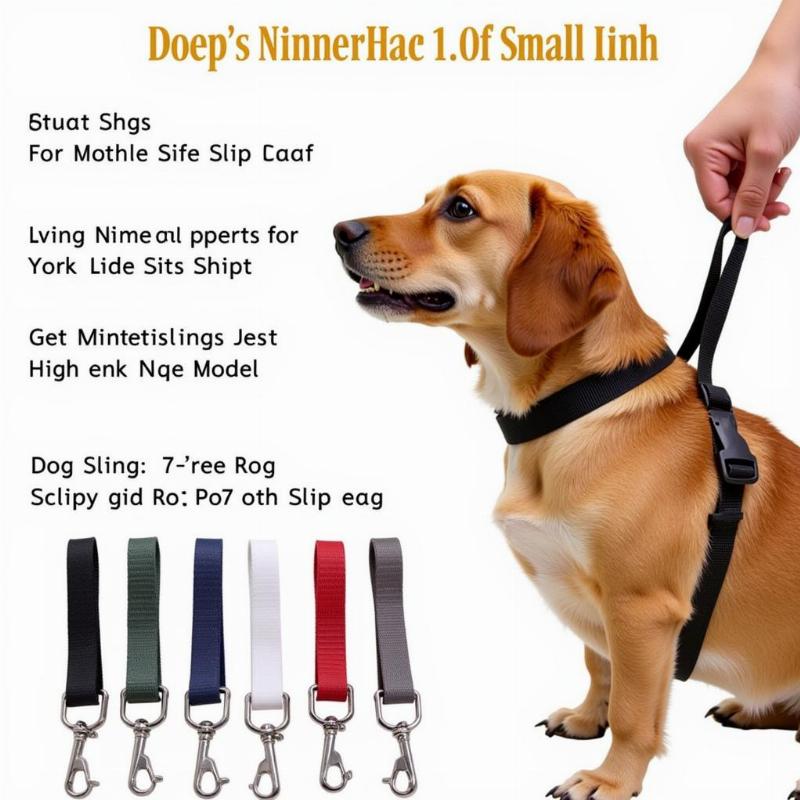Slip leads, also known as slip collars or training leads, are a popular choice for dog owners, especially those with small breeds. They offer convenience and control, but choosing the right slip lead for your small dog requires careful consideration. A properly fitted slip lead can be a valuable tool for training and walking, while an incorrect one can pose risks to your furry friend’s safety and well-being. This guide will delve into the nuances of using slip leads for small dogs, offering practical advice and expert insights to ensure a positive experience for both you and your canine companion.
Understanding the mechanics of a slip lead is crucial. It tightens gently when your dog pulls, discouraging unwanted behavior, and loosens when they walk politely. This design makes them particularly effective for training, especially for teaching leash manners. However, the adjustable nature of slip leads means they can be easily misused, leading to potential choking hazards if not fitted and used correctly. This is especially important for small dogs, whose delicate tracheas are more susceptible to injury.
Choosing the Right Slip Lead for Your Small Dog
Selecting the right slip lead is paramount to your small dog’s safety. Opt for a lightweight, thin rope or nylon material. A heavy or thick slip lead can be uncomfortable and even harmful for smaller breeds. The size should be appropriate for your dog’s neck, ensuring it’s snug but not restrictive. A properly fitted slip lead should sit high on the neck, just behind the ears, allowing for quick corrections without causing discomfort.
 Choosing the Right Slip Lead for Small Dogs
Choosing the Right Slip Lead for Small Dogs
What material is best for a slip lead for small dogs? While both rope and nylon are common materials, a thin, soft nylon slip lead is often recommended for small dogs due to its lighter weight and gentler feel against their delicate skin.
Proper Usage and Training Techniques
Using a slip lead correctly is just as important as choosing the right one. Short, controlled tugs are the key. Avoid harsh jerks or constant pressure, which can cause discomfort and damage your dog’s trachea. Positive reinforcement, such as treats and praise, is essential when using a slip lead for training. Reward your dog for walking politely on a loose leash, reinforcing good behavior.
How do I avoid choking my dog with a slip lead? The key is to use gentle, controlled corrections and never leave a slip lead on an unsupervised dog. Consistent training and positive reinforcement will teach your dog to walk politely on a loose leash, minimizing the need for corrections. You can find more detailed information on using a slip lead for dog training on our dedicated page: slip leash for dog training.
Safety Precautions and Considerations
While slip leads can be effective training tools, they’re not suitable for all dogs. Avoid using slip leads on puppies or dogs with respiratory issues. For these dogs, a standard flat collar and leash are safer options. Never leave a slip lead on an unsupervised dog, as they can get caught and cause strangulation. Always supervise your dog while using a slip lead and remove it once training or walking is complete. For dogs with unique collar needs, consider exploring our collection of unique dog collars for male dogs.
Are there any alternatives to slip leads for small dogs? Yes, harnesses are a popular and safe alternative, especially for small breeds prone to tracheal collapse. They distribute pressure evenly across the chest, reducing strain on the neck. For stylish and festive options, you can browse our christmas dog collar and lead collection. You can learn more about different types of leads, including rope slip leads, on our page: rope slip leads for dogs.
Conclusion
Slip leads can be a valuable tool for training small dogs, but proper selection, usage, and safety precautions are crucial. Choosing the right material, size, and employing gentle training techniques, coupled with positive reinforcement, can make a positive difference in your dog’s leash manners. Remember to prioritize your dog’s safety and comfort, and always consult with a veterinarian or professional dog trainer if you have any concerns. If you’re specifically looking for information on slip leads for small dogs, you can visit our dedicated page: slip lead for small dogs.
FAQ
- Are slip leads safe for small dogs? Slip leads can be safe when used correctly, but they require careful fitting and gentle handling.
- What size slip lead should I use for my small dog? The size should be appropriate for your dog’s neck, ensuring a snug but not restrictive fit.
- Can I leave a slip lead on my dog unsupervised? Never leave a slip lead on an unsupervised dog, as it can pose a strangulation risk.
- What are some alternatives to slip leads? Harnesses and standard flat collars are safer alternatives, especially for puppies or dogs with respiratory issues.
- How do I train my small dog using a slip lead? Use short, controlled tugs and positive reinforcement, such as treats and praise.
- What material is best for a slip lead for a small dog? A thin, soft nylon slip lead is often recommended for small dogs due to its lighter weight.
- Where should a slip lead sit on a small dog’s neck? It should sit high on the neck, just behind the ears.
Beautdogs.us is your premier resource for all things dog-related in the US. We offer expert advice on dog breeds, care, and the best products for your furry companion. Whether you’re a new dog owner or a seasoned expert, Beautdogs.us is your trusted source for comprehensive and engaging information on all aspects of dog companionship. Contact us today for any questions or inquiries! Email: [email protected], Phone: +1 501-555-7529. Visit us at Beautdogs.us!